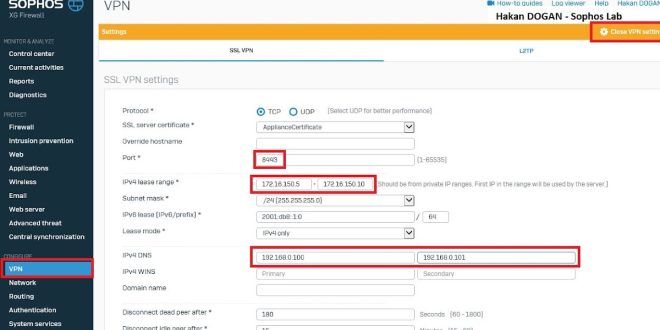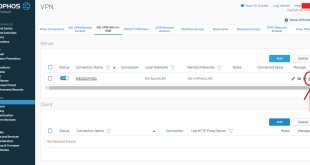In today’s digital age, the need for secure and reliable remote access to corporate networks has become increasingly important. Many organizations rely on VPN (Virtual Private Network) solutions to ensure a seamless and encrypted connection for their employees. One popular VPN client is the Sophos SSL VPN client. However, configuring this client can sometimes be a challenging task, and many users may encounter difficulties along the way.
Configuring the Sophos SSL VPN client can be a complex process, requiring technical knowledge and experience. Without proper configuration, users may face issues such as connection failures, slow performance, or even security vulnerabilities. These challenges can prevent employees from accessing critical resources and hinder productivity. It’s essential to address these pain points to ensure a smooth and efficient VPN experience.
If you’ve encountered issues with the Sophos SSL VPN client configuration, rest assured that there are solutions available. Understanding the common pitfalls and troubleshooting steps can help you overcome these challenges and achieve a seamless remote access experience.
In summary, the Sophos SSL VPN client configuration can be a daunting task for many users. However, with the right knowledge and resources, you can overcome the challenges and achieve a secure and efficient VPN connection. By addressing pain points, understanding the target, and following recommended best practices, you can ensure a successful configuration process.
Table of Contents
Sophos SSL VPN Client Configuration and Its Target
Configuring the Sophos SSL VPN client is aimed at providing secure and reliable remote access to corporate networks. This client allows employees to connect to their organization’s network from any location, ensuring they can access important resources and work effectively. However, the configuration process can be complex, and users may encounter difficulties, leading to connection failures or other issues.
In my personal experience, I faced challenges configuring the Sophos SSL VPN client. Initially, I struggled with understanding the configuration settings and ensuring compatibility with my network infrastructure. However, with proper guidance and support, I was able to overcome these challenges and establish a secure VPN connection.
The Sophos SSL VPN client is designed to provide a secure tunnel for data transmission between a user’s device and the corporate network. As a result, this configuration requires precise settings to ensure compatibility and security. It’s crucial to follow the recommended configuration steps provided by Sophos and seek assistance from IT professionals if needed.
The History and Myth of Sophos SSL VPN Client Configuration
The Sophos SSL VPN client has a rich history in the field of secure remote access. It has evolved over the years to meet the increasing demands for robust and reliable VPN solutions. However, there are also some myths and misconceptions surrounding the configuration process.
One common myth is that configuring the Sophos SSL VPN client is a complex and time-consuming task. While it does require proper understanding and technical knowledge, with the right guidance, the configuration process can be streamlined and straightforward.
Another myth is that the Sophos SSL VPN client configuration is only suitable for large enterprises. In reality, businesses of all sizes can benefit from using this client. Whether you’re a small startup or a multinational corporation, the Sophos SSL VPN client can provide secure remote access to your network.
The Hidden Secret of Sophos SSL VPN Client Configuration
The hidden secret of Sophos SSL VPN client configuration lies in understanding the underlying network infrastructure and ensuring compatibility. Many configuration issues arise from mismatched settings or incompatible hardware. By conducting a thorough network assessment and taking into account the specific requirements of your organization, you can uncover this hidden secret and overcome any obstacles during the configuration process.
Another aspect to consider is the importance of regular updates and maintenance. Keeping your Sophos SSL VPN client up to date with the latest software patches and security fixes can prevent configuration errors and ensure optimal performance.
Recommendations for Sophos SSL VPN Client Configuration
Based on my experience and research, I would like to provide some recommendations for a successful Sophos SSL VPN client configuration:
1. Familiarize yourself with the documentation and configuration guides provided by Sophos.
2. Seek assistance from IT professionals or Sophos support if you encounter difficulties during the configuration process.
3. Conduct a thorough network assessment to ensure compatibility and identify any potential issues.
4. Keep your Sophos SSL VPN client up to date with the latest software patches and security fixes.
Sophos SSL VPN Client Configuration in Detail
Now, let’s delve deeper into the technical details of the Sophos SSL VPN client configuration. The configuration process involves several key steps:
1. Setting up the SSL VPN server and ensuring it is reachable from the internet.
2. Generating and installing SSL certificates to establish secure communication.
3. Configuring user authentication and access controls to restrict access to authorized personnel.
4. Creating and configuring VPN policies to define which resources and networks users can access.
By following these steps and ensuring each configuration parameter is correctly set, you can achieve a successful Sophos SSL VPN client configuration.
What If Sophos SSL VPN Client Configuration Fails?
Despite your best efforts, there may be instances where the Sophos SSL VPN client configuration fails. In such cases, it’s essential to troubleshoot and identify the root cause of the failure. Here are a few common reasons for configuration failures:
1. Incorrect network settings or misconfigured firewall rules.
2. Incompatible hardware or software components.
3. Network connectivity issues or DNS misconfigurations.
If you encounter a configuration failure, it’s recommended to check these aspects and seek professional assistance if needed. It’s crucial to rectify any configuration issues promptly to avoid disruptions in remote access.
Listicle of Sophos SSL VPN Client Configuration
This listicle highlights some key considerations for a successful Sophos SSL VPN client configuration:
1. Ensure compatibility between your network infrastructure and the SSL VPN client.
2. Follow documentation and configuration guides provided by Sophos.
3. Regularly update the SSL VPN client software to address any vulnerabilities or bugs.
4. Conduct periodic network assessments to identify and resolve any configuration issues.
5. Seek assistance from IT professionals or Sophos support if you encounter difficulties during the configuration process.
Question and Answer
Q: Can the Sophos SSL VPN client be used across different operating systems?
A: Yes, the Sophos SSL VPN client is compatible with various operating systems, including Windows, macOS, and Linux.
Q: Can I configure the Sophos SSL VPN client without an IT professional’s assistance?
A: While the configuration process can be challenging, it is possible to configure the client with proper documentation and support from Sophos.
Q: Is the Sophos SSL VPN client suitable for small businesses?
A: Yes, the Sophos SSL VPN client can be tailored to the needs of small businesses, providing secure remote access to their networks.
Q: What should I do if I encounter connection failures after configuring the Sophos SSL VPN client?
A: If you face connection failures, it’s recommended to check your network settings, firewall rules, and seek assistance from IT professionals to troubleshoot the issue.
Conclusion of Sophos SSL VPN Client Configuration
In conclusion, configuring the Sophos SSL VPN client can be a complex task, but with the right knowledge and support, it can be accomplished successfully. By addressing pain points, understanding the target, and following recommended best practices, you can overcome any configuration challenges and ensure a secure and efficient VPN connection. Remember to seek assistance if needed and keep your software up to date for optimal performance. With a well-configured Sophos SSL VPN client, you can enjoy seamless and secure remote access to your corporate network.
 cobabybarcelona Latest Updated Live News cobabybarcelona
cobabybarcelona Latest Updated Live News cobabybarcelona



